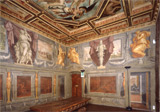Museo di Casa Vasari
This is an illustrious example of an artist’s family home, where Giorgio Vasari celebrated his thinking and his art. Richly decorated with frescos and a priceless collection of Mannerist paintings, the interiors are a testimony to the highest expression of sixteenth-century artistic civilisation in Italy.As he himself wrote in his autobiography, Vasari bought this house in 1541, describing it as “located in Arezzo, with room for making beautiful kitchen gardens, in the borgo of San Vito, which has the purest air in the city”.
After completing the architectural work, Vasari started applying himself to decorating it with his paintings in 1542, although he did not complete this until some time after 1568. Despite the fact that several centuries have passed since Vasari’s day, the building’s main interiors have been preserved substantially unchanged to this very day.
Vasari frescoed the rooms as a way of celebrating the role played by the artist, choosing scenes taken from the Bible or from mythology and numerous allegories, creating an exemplary testimony of the sixteenth-century civilisation of which he was such a major exponent.
At the beginning of the 1950s, a significant collection of paintings was also housed here, including works by Vasari himself, by his assistants and by other Tuscan artists, making the house into a small but priceless museum devoted to Mannerism.








